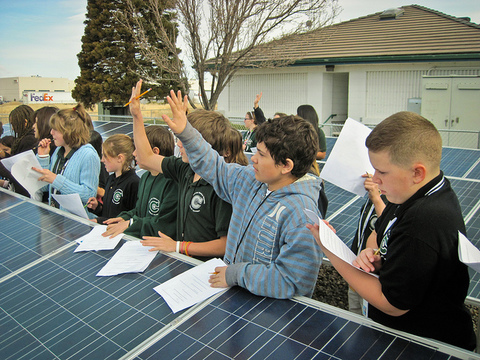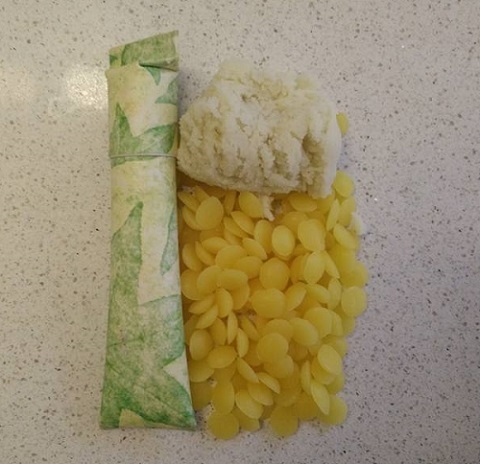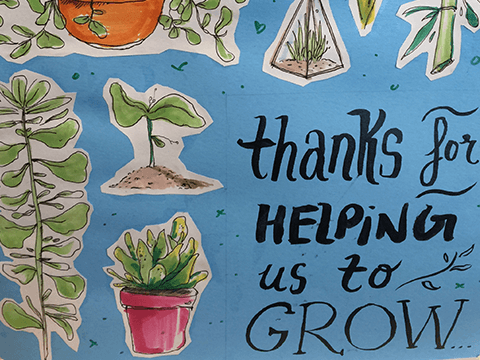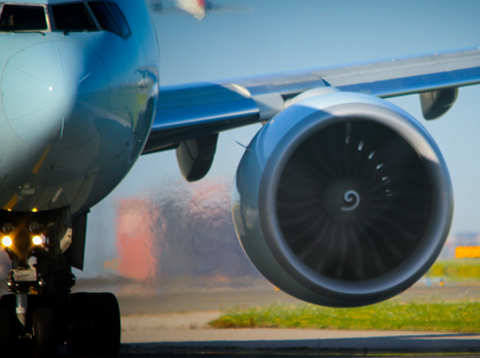David Suzuki's Blog, page 27
September 21, 2016
Toronto's "solar schools" inspire climate optimism

(Credit: BlackRockSolar)
In spring 2014, the Toronto District School Board -- Canada's largest -- embarked on a program of putting photovoltaic panels on more than 300 of its school buildings. When complete, it will create enough power to meet the annual needs of about 4,250 homes. But Richard Christie, senior manager of the board's sustainability office, says the program generates far more than electricity.
The Solar Schools Project had its genesis in a pilot, launched in 2010, for which small (one- to 46-kilowatt) solar arrays were placed on 12 schools. Income produced through sales of this power helped establish the board's Environmental Legacy Fund, which gives teachers $400 toward the cost of a $650 course in ecological education. "These courses will have a big impact on the [school] system," Christie explains. "Ten years from now we'll see a lot more principals who have environmental education as a priority because they took these courses when they were teachers."
After the success of its pilot, the school board wanted to scale up. It created a partnership with renewables developer School Top Solar Limited, which commissioned assessments of the sunlight potential and structural integrity of hundreds of school roofs and assisted the board in submitting feed-in tariff applications to the Ontario Power Authority. In the end, the partnership was awarded FIT contracts to put solar panels on 311 buildings. But there was a catch: To accommodate the panels, many of the schools needed new or upgraded roofing.
Under the partnership, School Top agreed to repair or wholly replace the roofs -- some of which were badly degraded -- and install and maintain the solar arrays. In return, the board granted the solar developer a licence to use the space and receive the FIT contract revenue. The project's scale is staggering: some 400,000 square metres of roofing will be replaced or fixed.
Also exciting is the fact the new roofs will come with insulation. (Prior to the project's commencement, most Toronto public school roofs lacked this.) So the environmental advantages are multiple. "When looking at the solar roof program, people tend to focus on the benefits of solar electricity generation, and of course that's there," Christie says. "But perhaps an even bigger environmental benefit is the GHG reduction associated with reduced use of natural gas due to roof insulation." The project is inspiring, even exhilarating, because it combines two key climate solutions: emissions-free power production and conservation of heating fuel. It brings us closer to attaining a central ecological objective: the creation of net-zero-carbon buildings.
Solar Schools has an educational component. "In Grade 6 science, kids learn about electricity," Christie explains. "In 2011, the board created a new resource guide on electricity which talks a lot about solar. As schools get panels, kids' interest in solar rises." To further boost their engagement in the project, the board is setting up an online dashboard so students can see how much power their array creates and how much energy their building consumes.
The project's greatest virtue may be its contribution to what I would call climate optimism. It reminds students that not all news is gloomy. Hopeful possibilities exist, and indeed some are taking root in their own school. "[The] solar roofs help kids overcome despair," Christie says. "Kids see that, with their help, we can change the world for the better. This foundational experience is key."
Hey! Want more DSF? Join David Suzuki on Facebook

September 19, 2016
Click to call your MP to ask for investment in transit
HERE ARE SOME TIPS FOR THE CALL
Use a headset or hands-free -- This will give you both hands to take notes about what was said.
Think about what you will say -- Consider how better transit will make a difference in your life or that of your family members. Some examples include minimized congestion, shorter commuting times, more comfortable rides, more affordable service, better quality of life, helping to fight climate change, better air quality, etc. Even if you think your transit commute is pretty good, there is always room for improvement, and increased transit funding will help more people get out of their cars.
Be polite -- MPs are our elected representatives. They will likely be happy to hear from engaged constituents. Most MPs will be very receptive to investment in transit, so we want to ensure we are encouraging them to support further investment, rather than being confrontational.
Hey! Want more DSF? Join David Suzuki on Facebook

Take an MP on your commute
HERE ARE SOME TIPS FOR THE CALL
Use a headset or hands-free -- This will give you both hands to take notes about what was said.
Think about what you will say -- Consider how better transit will make a difference in your life or that of your family members. Some examples include minimized congestion, shorter commuting times, more comfortable rides, more affordable service, better quality of life, helping to fight climate change, better air quality, etc. Even if you think your transit commute is pretty good, there is always room for improvement, and increased transit funding will help more people get out of their cars.
Look at your calendar - Be ready to schedule a date and time with your MP the week of October 10 to 16 or November 7 to 13. Be open to other times the MP's staff may suggest.
Be polite -- MPs are our elected representatives. They will likely be happy to hear from engaged constituents. Most MPs will be very receptive to investment in transit, so we want to ensure we are encouraging them to support further investment, rather than being confrontational.
Be direct -- Political staff can be skilled at avoiding making commitments. After you've explained what you are calling for, ask them directly whether the MP can join you on your commute or when to expect an answer.
Hey! Want more DSF? Join David Suzuki on Facebook

September 17, 2016
How to make lip balm

Make lip balm with shea butter, beeswax, avocado oil and then store in compostable paper tubes! (Credit: Lindsay Coulter)
Pucker up!
Make your own lip balm--something many of us use daily. This simple, effective recipe contains no toxic chemicals, so it's healthy for your skin AND the planet.
Lip balm recipe
Time needed: ten minutes
Shelf life: approximately six months
5 ml (1 tsp) organic, fair trade shea butter or cocoa butter
15 ml (1 Tbsp) avocado oil
15 ml (1 Tbsp) local beeswax (grated or pastilles) or soy wax
Optional: 5 drops essential oil (e.g., peppermint, lime or grapefruit) and/or 1 drop Vitamin E oil.
Put about 50 ml (1/5 cup) of water into a small pot on low heat. Combine first three ingredients in a small metal bowl. Create a double boiler by placing the bowl on top of the pot. Stir ingredients until melted. Remove from heat. Add optional ingredients. Stir. Let cool. Store in air-tight container: Choose reusable tins, glass or look for paper tubes to avoid plastic.
Ingredient properties (find them at health food stores or most grocers):
Shea butter: Contains vitamins A and D (revitalizes skin), E (oxygenates) and F (keeps skin young and supple). Also protects skin from sun (SPF 3 to 6) and wind damage.
Cocoa butter: An antioxidant and emollient made from cocoa beans (a vegetable fat). Helps lubricate and smooth skin by locking in moisture.
Avocado oil: Full of beta carotene, vitamins C and E (SPF 4 to15).
Beeswax: Acts as a binding agent. Won't clog pores. Safe for all skin types. (Vegan? Try soy wax instead.)
Vitamin E (a.k.a. tocopheryl acetate): A powerful antioxidant that combats free radicals and oxidation damage. Also helps moisten and soften skin.
Once you try this double boiler process to melt oils and wax, try other lip balm recipes -- even create your own! Research the properties of various butters and oils here.
Why make lip balm?
Petrolatum (a.k.a. mineral oil jelly), found in many lip balms, hair care products, soaps and skin care products is one of our Dirty Dozen ingredients to avoid. It's used as a barrier to lock moisture into skin. It's also a petrochemical sometimes contaminated with cancer-causing polycyclic aromatic hydrocarbons. The European Union considers it a carcinogen and restricts its use in cosmetics.
Protect your lips from the elements. Make extra for gifts. Safe for kids, too. (Note: People with nut allergies may have an adverse reaction to shea butter because it comes from the nut of the karite tree. Use cocoa butter instead.)
Please share your review in the comments below.
Sincerely,
Lindsay Coulter, a fellow Queen of Green
Hey! Want more DSF? Join David Suzuki on Facebook

September 15, 2016
How Camp Suzuki: Howe Sound 2016 helped Vision Youth grow

Roughly six months ago, I planted a seed. I met a group of conscientious parents, their teenage children and the co-founder of Vision Youth, Eric Li, in Markham, Ontario.
I presented to them what Camp Suzuki: Howe Sound 2015 did and what Camp Suzuki: Howe Sound 2016 will do for their fast-growing teenagers.
Fast forward to early August, when eight participants from Vision Youth joined us for Camp Suzuki: Howe Sound at Camp Fircom on Gambier Island, B.C.
Aiken, Johnathan, Keefe, Curtis, Connie, Eric, Alex and his mother Pansy joined the David Suzuki Foundation's Camp Suzuki for young adults. They came with their team lead and Vision Youth gold program vice-president Brian Yee, who is only a few years older than the group. Together, they made history for me, Vision Youth and the David Suzuki Foundation. Here's what they had to say.
Connie Chou: "This camp has motivated me to take action. I no longer want to spend my time lying down on my bed or staying at home."
Keefe Chan: "This camp has raised my level of awareness around First Nations and the environmental issues which impact our lives."
Jonathan Yeo: "Camp Suzuki: Howe Sound has widened my knowledge of the environment and the role we play. It will help me make sound decisions as a leader in school or in projects while keeping the environment in mind."
Eric Li: "The workshops have made me realize change begins with us and we can make an impact no matter how big and small."
Curtis Lee: "The camp showed me the benefit of unplugging myself and taking in the nature around me."
Aiken Chau: "I am bringing back a different perspective on environmental issues. I am much more conscious of how pollution impacts us and I believe Camp Suzuki: Howe Sound would benefit my city, Toronto! I look forward to making this a reality."
[image error]
As a public engagement specialist, I could not have expected a better outcome -- young people from diverse backgrounds joined to support and learn about the environment and life. The Vision Youth participation this year not only enriched our camp, it also expanded our horizon in environmental public engagement. And there is nothing more gratifying to learn that the feeling was mutual!
Curtis Lee: "Camp Suzuki: Howe Sound not only provided us the opportunity to get outside of Ontario and away from our parents, it also helped us learn more about the environment and the First Nations in Canada."
Aiken Chau: "Camp Suzuki: Howe Sound was a lot more than what we expected. We thought it would be a typical camp-like environment. Instead, we learned a lot more about ourselves with a focus on personal identity."
Making new friends and learning what we can do if we embrace the environment and diversity that surrounds us are crucial to a sustainable future. I have a feeling this will not be the last time we hear from these fantastic young people. And it surely will not the be last time they hear from me!
[image error]
According to Yee, VY's gold program lead and vice-president, Vision Youth is a volunteer run leadership development program based in Toronto. Their program focuses on giving youth the skills and knowledge to become leaders within their communities by introducing participants to outdoor, community and interpersonal leadership.
Hey! Want more DSF? Join David Suzuki on Facebook

David Suzuki Foundation supports Victoria sewage treatment
VANCOUVER -- After delays and continuing debate about the best sewage-treatment option for Victoria, the Capital Regional District agreed yesterday to proceed with a revised design for construction of a sewage-treatment plant at McLoughlin Point in Esquimalt.
"We support the decision to move ahead. It has been a decade since the provincial government ordered the CRD to build sewage-treatment facilities," said John Werring, senior science and policy adviser with the David Suzuki Foundation. "With this decision to proceed, it's time to stop talking and polluting and start building." The waste water treatment plant will provide tertiary, which includes high level filtering, sewage treatment by 2020.
The CRD was ordered in 2006 to have a sewage-treatment plant running by this year. Following years of public consultation and technical input, the CRD was on its way to meeting that goal with a plan to build a secondary treatment plant at McLoughlin Point. By 2014, the process was derailed by organized opponents who argued that sewage treatment was unnecessary, and the plan and consultation inadequate.
"We're hopeful that yesterday's decision will put this issue to rest in the region. Moving ahead with a sewage-treatment plan backed by strong science is not only the right thing to do, it is essential," Werring said. "Dumping raw sewage into the ocean is simply unacceptable for any forward-thinking community."
- 30 -
Media contact:
John Werring, Senior Science and Policy Adviser, David Suzuki Foundation
Cell: 604-306-0517
Hey! Want more DSF? Join David Suzuki on Facebook

Airline emissions are flying too high

(Credit: Farhan Amoor via Flickr)
In July, Solar Impulse 2 became the first airplane to fly around the world without using fuel. At the same time, the U.S. National Aeronautics and Space Administration has been working on electric planes. These developments mean air travel and transport could become more environmentally friendly, with less pollution and fewer greenhouse gas emissions, and planes would be quieter.
As promising as solar and electric planes may be, these technologies still have a way to go and won't likely usher in a new era of airline travel soon. That's unfortunate, because aircraft are major sources of pollution and climate-altering greenhouse gases, contributing the same amount of emissions as Germany, about two per cent of the global total. As air transport becomes increasingly popular, experts project aircraft emissions could triple by 2050.
Analysis by U.K.-based Carbon Brief found that, under business as usual, a growing commercial aviation industry could contribute 27 per cent of allowable emissions between 2015 and 2050 if the world is to meet the 2015 Paris Agreement's aspirational 1.5 C target for global average temperature increase -- and that other factors, such as nitrogen oxide and water vapour emissions and contrails, could exacerbate climate impacts.
Air travel is also an area where there's a huge discrepancy between those who benefit and those who suffer. The wealthiest three to five per cent of the world's population are the biggest users of international aviation, while the impacts of climate change fall disproportionately on the world's poorest.
Despite their emissions, airplanes haven't been included in climate change accords like the Paris Agreement. That's changing: A new deal to impose limits on aircraft emissions will be considered for approval at the UN International Civil Aviation Organization assembly in Montreal from September 27 to October 7. Many fear the proposed agreement doesn't go far enough.
Earlier this year, ICAO's technical committee agreed on efficiency standards for new aircraft. Although improving each new plane's efficiency will help slow growth in aviation's carbon pollution, the numbers of new planes taking to the skies means overall emissions will skyrocket without other measures. In 2013, ICAO committed to agree, by the time of the upcoming 2016 assembly, on a market-based measure to keep net emissions from international flights from rising above 2020 levels.
This pledge means all but the least emitting countries would require their airlines to stabilize emissions at 2020 levels. Airlines that exceed the cap would have to buy offsetting emission reductions from companies that cut their carbon pollution below it. That framework is on the table for the assembly, but it's been watered down significantly. Any country can opt in or out of the system until 2027, and targets until then are voluntary. That creates uncertainty over whether countries like China will join.
If ICAO's 191 member nations fail to reach a strong aviation agreement in Montreal, it could undermine the world's ability to meet the Paris Agreement's climate goals. In the absence of a robust international agreement on aviation carbon pollution, ICAO member nations would be left to implement their own policies, which could result in an ineffective, piecemeal approach.
The non-profit civil society member organizations of the International Coalition for Sustainable Aviation are urging ICAO to enact a "climate deal which meets the 2020 goal, has the widest possible participation, has environmental and social safeguards for the offsets and alternative fuel used and increases ambition in line with the requirements of the Paris Agreement."
Although the greater stability international agreements would provide over scattered domestic policies and regulations means the aviation industry is mostly on-board, governments have been reluctant to sign on to strong measures.
It's time for industry and governments to take much-needed steps to bring this major emissions source under control, especially as air traffic continues to increase. We can hope that new technologies such as solar-powered and electric planes will develop quickly enough to make a difference, and we can try to limit our personal use of air travel, and buy high-quality carbon offsets when we do fly, but international agreements are crucial.
Let's urge government representatives to come up with a strong, enforceable agreement that helps meet the Paris Agreement objectives. If that speeds up development of planes that produce no emissions or far fewer than current aircraft, even better.
Hey! Want more DSF? Join David Suzuki on Facebook

Public transit funding emerging as a key election issue
For immediate release
VANCOUVER - The David Suzuki Foundation is encouraged by the recent attention being paid to public transit funding in the lead-up to next year's B.C. provincial election. Today, the B.C. NDP released a statement promising it would increase the provincial share of funds invested in new transit projects from 33 to 40 per cent. This commitment is aligned with recommendations the DSF made in June 2016 as part of our report Breaking Gridlock: B.C.'s transit investment deficit and what can be done to fix it.
"Today's commitment from the B.C. NDP, along with the B.C. government's announcement earlier this year to fund the first stage of transit expansion in Metro Vancouver, hints that public transit investment is likely to become a major election issue," said Ian Bruce, director of science and policy for the DSF. "With congestion clogging our roads and population growing rapidly, we need political leaders who will prioritize improvements to our transit systems."
Studies suggest Vancouver is the most traffic-congested city in Canada and that the cost of this congestion is upwards of $1 billion per year to the regional economy. Emissions from vehicles stuck in traffic also erode air quality and contribute to climate change. Road transportation is currently responsible for 25 per cent of B.C.'s greenhouse gas emissions. Fast, effective public transportation networks can reduce these emissions.
"Public transit bolsters the economy, provides people with better access to jobs and social services, improves public health by bettering air quality, and reduces carbon emissions and traffic," Bruce added. "Investing in transit is a political home run for any party hoping to win the election."
Metro Vancouver mayors have developed a 10-year vision for transit improvements in the region. Phase 1 of the plan received funding from federal, provincial and municipal governments earlier this year, but the bulk of the necessary investment remains uncertain. If Phase 2 funding is not secured soon, delays could drive up the cost of delivering projects and lead to more traffic gridlock.
For more information, contact:
David Suzuki Foundation - Steve Kux: 604-374-4102
David Suzuki Foundation - Theresa Beer: 778-874-3396
Hey! Want more DSF? Join David Suzuki on Facebook

September 8, 2016
The simple-minded nature of human super predators

(Credit Jeremy Weber via Flickr)
Humans are the world's top predator. The way we fulfil this role is often mired in controversy, from factory farming to trophy hunting to predator control. The latter is the process governments use to kill carnivores like wolves, coyotes and cougars to stop them from hunting threatened species like caribou -- even though human activity is the root cause of caribou's decline.
Predation is an important natural function. But as the human population has grown, we've taken over management of ecosystems once based on mutually beneficial relationships that maintained natural balances. How are we, a "super predator" as the Raincoast Conservation Foundation dubs us, aligning with or verging from natural predation processes that shaped the world?
One way to tell is to examine the extent to which we emulate natural processes. This principle is applied in biomimicry, where humans base inventions on natural forms and functions. (Think Velcro, patented in 1955 after George de Mestral studied the burrs on his dog's back.) Some resource-management disciplines employ biomimicry. For example, forestry management is often based on trying to imitate disturbances caused by natural events such as fires.
If we are to emulate natural predators, we must look at the types of prey killed. Non-human predators usually take down the injured, old or young. This leaves the strongest genetic material to be passed on. Human predators often target the largest males (trophy hunting) or entire packs (predator control).
In the wild, non-human predators rarely kill top predators. A Science report concluded humans kill large predators at nine times the rate at which carnivores typically kill each other.
There are also differences in how prey are killed. Natural predation is violent. But human predation often goes to another level. In addition to using aerial shooting and poison baits, reports indicate British Columbia employed "Judas wolves", radio-collared wolves used to track down packs so they can be killed. The Judas wolves are left alive so that if they join a new pack, those wolves can be killed, too. It's hard to see how this fits within the boundaries of natural predation. (The B.C. government denies using Judas wolves.)
Human management regimes such as predator control and trophy hunting disrupt healthy predator-prey dynamics and damage ecosystems. Sadly, this is often a moot point: Alberta and B.C. use predator control because the landscape has been so pummelled by industrial activity that the large, intact forests caribou need to survive and avoid predation no longer exist. Predators are targeted as scapegoats for human activities.
Predators usually kill for sustenance. For millennia, Indigenous peoples have also relied on hunting to maintain traditional ways of life. But with trophy hunting, the government's impetus is to make money. Governments that allow continued resource extraction in imperilled caribou habitat are using predator control as a stopgap measure to keep caribou alive.
In ecosystems managed by natural processes, and not for resource extraction, predators play a key role in maintaining the environment's health. In Trends in Ecology and Evolution, Enric Sala notes that predators "can regulate the structure of entire communities."
Ultimately, natural predator-prey relationships are symbiotic. Predators not only keep prey populations in check and maintain natural cycles, they can even heal degraded ecosystems. Wolves reintroduced into Yellowstone National Park in 1995 restored the natural biodiversity that had diminished in their absence. To avoid predation, elk spent less time in valley bottoms, which allowed plants and trees to regenerate, in turn attracting birds, bears and beavers. Vegetation stabilized riverbanks, beavers altered waterways and soon turtles, amphibians and river otters returned.
When judged by this dynamic of upholding natural balances, humans are failing terribly as predators. It's hubris to think we can manage complex ecosystem dynamics using simple-minded band-aid approaches.
What can we do to become better? We can stop looking for scapegoats and look in the mirror at the primary cause of species' decline across Canada. We can end trophy hunting. We can end predator control by maintaining and restoring the habitat that caribou need to survive and recover. We can plan to operate within natural limits.
It's shocking that Western society villainizes predators like wolves, even though they're highly intelligent, social creatures that play a critical role in regulating nature. The predator we need to control is us!
Hey! Want more DSF? Join David Suzuki on Facebook

September 6, 2016
First B.C. wild salmon fisheries red-listed due to struggling salmon populations
VANCOUVER/HALIFAX -- For the first time, the Monterey Bay Aquarium's Seafood Watch program has ranked four commercial British Columbia salmon fisheries as "avoid", largely because of low population numbers. Today's report includes assessments for chinook and coho salmon commercially caught in B.C. The report identifies 10 fisheries that represent about 99 per cent of the total chinook and coho catch as having "some concerns". Four fisheries responsible for the remaining one per cent of the catch were ranked as "avoid". The rankings provide information to consumers who want to purchase sustainably caught seafood.
"These rankings confirm fears about declining wild salmon populations heard across B.C. this summer," said Jeffery Young, senior science and policy advisor at the David Suzuki Foundation, a SeaChoice member. "I'm sure British Columbians will agree that it's essential for fisheries to do their part to allow declining salmon populations to recover."
Chinook and coho populations are suffering most in the southern part of the province, even though catches have been reduced. B.C. fisheries are also catching salmon stocks listed as threatened or endangered under the United States Endangered Species Act. "It's pretty clear these fisheries are not sustainable when they are targeting threatened or endangered fish," said Susanna Fuller, SeaChoice member from the Ecology Action Centre.
Recreational fisheries were not assessed in this report but also catch these wild salmon. "Making matters worse, recreational fisheries are catching even more of these struggling populations than their commercial counterparts," Young said. "There's a confluence of issues, ranging from too many fishing licences allocated to small areas, challenges connected to hatcheries and fishing that crosses international borders, that make fisheries complex to manage. These unsustainable fisheries are a warning to all commercial and recreational salmon fisheries to take measures now to become more sustainable if they want fish to catch in the future."
Wild salmon face myriad threats, including diseases from open-net aquaculture, ocean warming and acidification related to climate change, and habitat destruction. Low numbers of chinook and coho have big impacts on B.C.'s coastal ecosystems and life, especially southern resident killer whales, which now number 83 and are listed as endangered under Canada's Species at Risk Act. The whales rely on chinook as their primary food source. "This poor assessment has implications for more than just salmon. Killer whales won't survive if we can't protect their food source," Young said.
SeaChoice: Canada's most comprehensive sustainable seafood program focuses on solutions for healthy oceans. SeaChoice is operated by the David Suzuki Foundation, Ecology Action Centre and Living Oceans Society. Launched in 2006, SeaChoice helps Canadian businesses and shoppers support sustainable fisheries and aquaculture at all levels of the seafood supply chain. SeaChoice has created easy-to-use, science-based tools to help consumers make the best seafood choices. For more information, visit www.SeaChoice.org.
Media contacts:
Lana Brandt, SeaChoice: 778-833-2954
Jeffery Young, David Suzuki Foundation: 250-208-8714
Hey! Want more DSF? Join David Suzuki on Facebook

David Suzuki's Blog
- David Suzuki's profile
- 247 followers



